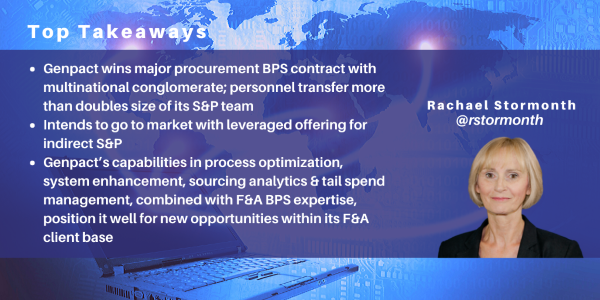Search posts by keywords:
Filter posts by author:
Related Reports
Related NEAT Reports
Other blog posts
posted on Nov 13, 2019 by Rachael Stormonth

Genpact has signed a procurement BPS contract with a multinational conglomerate to manage a spend of $10bn covering all major categories of indirect spend (except IT) including logistics, FM, MRO, professional services, travel, and contingent labor, globally.
The contract is of strategic importance to Genpact in that it involves the transfer of 130 category management and sourcing personnel, approximately doubling the scale of Genpact’s existing sourcing & procurement practice. Before the deal, Genpact had ~100 personnel in its sourcing & procurement practice, with an additional 50 S&P personnel elsewhere within the company.
The deal provides Genpact with nearshore sourcing category management delivery centers in Budapest and Monterrey together with additional capability in Bangalore (where Genpact already has a sourcing & procurement team) and a small center near Shanghai.
So it will have a major impact on the scale and level of expertise within Genpact procurement services. Genpact expects this new capability will enable it to maintain 20%+ growth over the next few years, and be instrumental in underpinning its new procurement BPS strategy consisting of:
- Integrated P2P
- Consulting in support of procurement optimization
- Sourcing & category management for leveraged indirect spend categories.
Taking Advantage of Accounts Payable Delivery to Target End-to-End P2P
Genpact has a major and longstanding presence in accounts payable, with ~14,000 personnel deployed on transactional P2P processing. While the majority of Genpact’s accounts payable clients do not currently purchase end-to-end P2P, the opportunities are increasing. Large enterprises with GBS operations have commonly appointed global process owners for P2P and these process owners are frequently looking to achieve “zero-touch” AP – and this can only be achieved by an end-to-end approach to P2P and ensuring that all purchases are digitized and coded and approved in error-free fashion at the procurement stage.
Accordingly, there is a major potential opportunity for Genpact to add procurement to at least some of these clients and provide end-to-end integrated procure-to-pay services.
Consultancy Services in Support of Procurement Optimization
Genpact recognizes that few major organizations will want to change their existing procurement platforms while at the same time frequently recognizing that their procurement capabilities require optimization. Here, Genpact expects its recent partnership with Celonis to be important, with digital twinning being used to show CPOs the “fact-based” reality of their operations.
Key tools then include micro-solutions such as dynamic workflow and elements of Cora, along with third-party point solutions.
Genpact has seven procurement consultancy offerings:
- Developing procurement target operating models
- Blueprinting, developing the execution plan to get to the target operating model
- Systems, small implementations around Coupa with the business growing organically and by word of mouth. Genpact is unlikely to acquire further implementation capability inorganically but has relationships with Coupa and Ariba and may look to add additional platform partnerships
- System optimization, firstly helping organizations optimize what they have bought and secondly helping them do procurement better. The latter could be around tail spend using solutions such as Tradeshift or using Cora dynamic workflow
- P2P optimization via process modifications and change management
- Sourcing diagnostics, using category expertise to identify possible opportunities
- Executing on the resulting short-term sourcing programs.
In addition to process analytics, sourcing analytics is also key, with Genpact’s F&A practice potentially a major source of category benchmark data.
Targeting Leveraged Indirect Sourcing & Procurement
Where the acquisition of these personnel is expected to have the greatest impact is in fundamentally facilitating Genpact in changing its offerings and delivery model for sourcing and category management.
Genpact will focus solely on sourcing indirect spend, and is aiming to own the execution and the delivery of sourcing & category management work by offering leveraged indirect sourcing and procurement services with a one-to-many model.
Genpact will not target high value, high-risk categories but will position as offering greater scale, repeatability, and savings in sourcing in the “leverage” category and in assisting organizations in eliminating, automating, and simplifying sourcing & procurement in very low risk, low-value categories. Genpact will target companies looking for a combination of “taking the noise out of the system” to improve the UX, potentially releasing some personnel to concentrate on more important categories, alongside achieving realized savings.
The contract with the conglomerate assists Genpact in acquiring centers “optimized for procurement with the right skill sets at the right price.” Clients will be offered a choice of delivery location, including onshore, nearshore for regional dependencies and language support, and offshore, with Bangalore being used for back-office support and for sourcing analytics. Genpact will look to use front-end category managers to serve multiple clients in a one-to-many model with resources in Bangalore and Budapest used to magnify their capacity and capability. Approximately 40% of Genpact sourcing & category management personnel are center-based with the remainder, including onshore personnel, more widely distributed.
Genpact will focus on the high-tech, manufacturing, & services, consumer goods, retail, life sciences, and healthcare sectors where it has gained experience of F&A BPS, and will aim to take prospective clients to “visual factories” based in their delivery centers where they can be walked through the sourcing & procurement process and also meet the category managers.
Sourcing & procurement BPS has traditionally been a difficult nut for vendors to crack; challenges have included its high geographic and category diversity, lack of talent (scaling category managers in this environment), lack of realistic offerings for tail spend management, and buy-side slowness to embrace S&P BPS, the latter partly because of limited choice in the vendor landscape. Genpact’s pragmatic approach to extending its business beyond transactional accounts payable to focus on S2P for low-risk indirect spend categories addresses some of these challenges. This approach, its newly expanded category management capabilities, and the fact that it has an extensive F&A client base to mine, position it well for future growth in a market where competition remains scarce.
